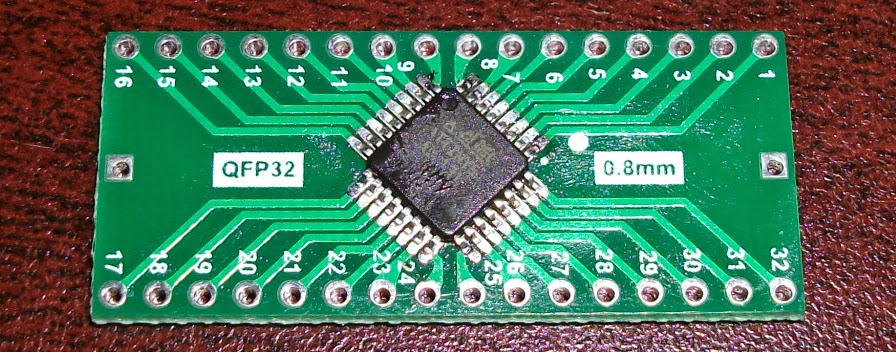Several months ago I noticed the Attiny88. It has several more I/O than the Atmega328, with an extra Port A and PC7. And unlike most of the other Attiny series, it has real SPI instead of USI, so libraries using SPI don’t have to be re-written. At just 86c for qty 1, it is the also the cheapest AVR with 8KB flash. Since QFP-32 parts aren’t easy to work with, I searched for breakout boards and found QFP32 to DIP32 boards that would allow me to use them in a small breadboard.
Breaking out a QFP Attiny88 AVR
I had lots of experience soldering through-hole parts, but not surface-mount. With the pin spacing of only 0.8mm, soldering individual pins with a standard soldering iron initially seemed like an impossibility. After reading some guides and watching a couple youtube videos, I realized I should be able to solder the QFP-32 chips with my trusty old pencil-style soldering iron.
Besides the QFP Atiny, I figured I’d get some passive SMD parts as well. I was surprised how cheap they are – 50c for 100 0.1uF ceramic capacitors and $3 for 1000 0805 resistors. I got a little carried away and even ordered a full reel of 5000 15K 0603 resistors that were on special for $5. Besides being more than I’ll probably ever use, the 0603 size is almost too small for hand soldering. Even the 0805 parts, at .08″ or 2mm long are a bit tricky to handle. The 0603 parts, at 1.6 by 08.mm, are the size of a bread crumb.
After all the parts arrived, I started by tinning the pads on the breakout board. That turned out to be a mistake since the leads from the tiny88 would slide off the solder bumps when I tried to solder the first lead. A dab of flux on the bottom of the chip helped keep it in place, but for the second chip I did I only tinned the pads in to opposite corners. I tack soldered one lead in one corner, adjusted it until it was straight, and then soldered the other corner.
Once the chip is held in place with two leads (double and triple-check it while it is easy to adjust), the rest of the leads can be soldered. On the first chip I tried I used too much solder, which caused bridging between some of the leads. So have some solder wick on hand. When I soldered the second board, I only tinned the tip of my iron, which was enough solder for about 4 leads, and avoided bridging. After the soldering is done check continuity between the leads and the DIP holes with a multimeter. Also check for shorts by testing the adjacent dip holes.
For more detail: Breaking out a QFP Attiny88 AVR

